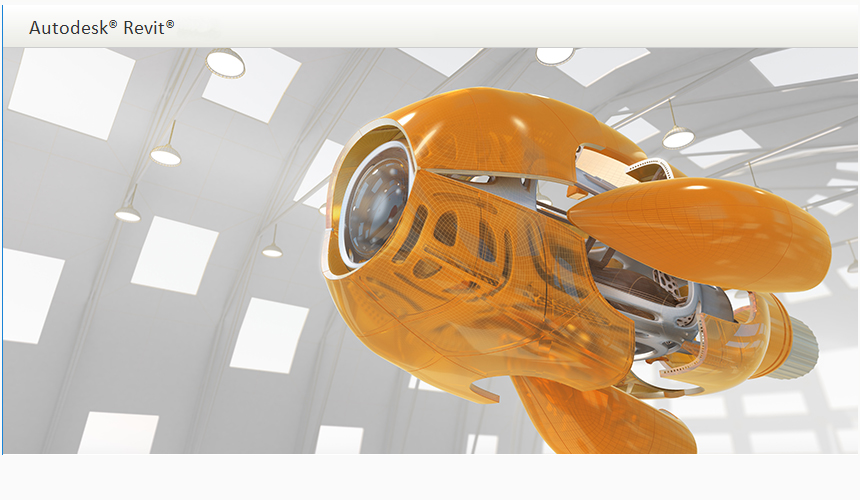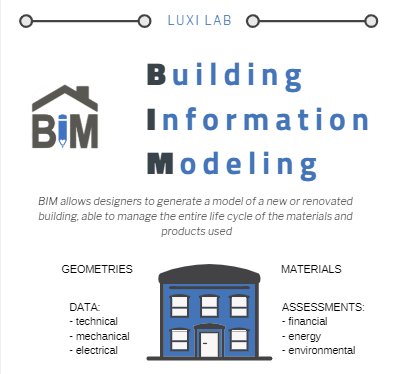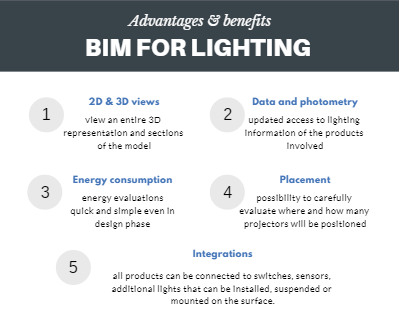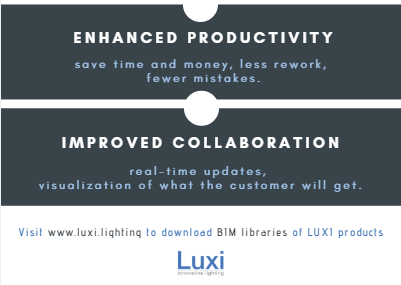BIM for lighting industry: download BIM library for Luxi products

The BIM, acronym of Building Information Modeling, allows designers to generate a model of a new or renovated building, able to manage the entire life cycle of the materials and products used and to understand all the intrinsic properties of the structure itself: geometries, technical and mechanical data, electrical data, material specifications, financial, energy and environmental assessments.
In order to support designers throughout the planning process, Luxi Illuminazione’s lighting division developed the BIM libraries for many of its products.
The developed BIM models offer a seamless integration of Luxi luminaires into projects in an easy and cost-free way.
BIM FAQ: Frequently Asked Questions
What are the benefits of using the BIM methodology for the lighting industry?
With BIM modeling, users can perform energy analysis and make more informed decisions about lighting fixtures.
BIM also offers a way to view an entire 3D representation and sections of the model.
It provides real-time coordination to assist with lighting design, and designers can access the rendering tools needed to complete the model visualization and energy assessments quickly and easily.
To give companies what they want, BIM allows lighting professionals to carefully assess where and how many projectors will be positioned during the preliminary design phase.
As more specifications are decided, additional information can be added to the model, such as lighting values of light switches, daylight sensors and presence sensors, as well as any additional lights embedded, suspended or mounted on the surface. .
What are the advantages of using a BIM approach when designing a building?
1. Enhanced productivity: save time and money, less rework, fewer mistakes.
The design process is faster and it is easier to communicate projects between teams. The advantage of the BIM-based approach makes it possible to create the intelligent model once and everyone can continue to use the data within the model throughout the process. If an element changes, the entire project adapts dynamically to changes.
2. Improved collaboration: real-time updates, visualization of what the customer will get.
The BIM-based approach allows project teams to collaborate in real time, update in progress and send alerts when changes occur. This helps to solve the subcontractor’s needs during planning, even before construction, avoiding difficulties in the field.
Several subcontractors can create and evaluate multiple alternatives and visually present them to project decision makers, so they can make smarter decisions early on and reduce the likelihood of errors.
Which programs to use to create projects in BIM methodology?
The BIM methodology is used by designers and lighting designers through specific licensed programs.
The most common software today is Revit by Autodesk. Designed for engineers, architects, planners, contractors and landscape architects, it is a robust Windows platform that offers an intelligent model-based approach to planning, designing and building infrastructure and buildings.
Revit allows you to create complex projects that can then be exported in the open IFC (Industry Foundation Class) format, with the extension .ifc to facilitate interoperability between the different architectural, construction and plant disciplines. IFC files are classified as intelligent 3D image files, which contain in addition to other technical information various encodings attributed to objects and artefact, and are compatible with all software using BIM technology.
The BIM Luxi libraries are therefore available in .rfa (Revit) format and on request are available 3D views in .dwg (Autocad), .dxf, .fbx format to ensure their use and easy import to all design studios .
BIM IS THE FUTURE
The legislation in Italy for the adoption of information modeling (BIM) in public works
As construction processes are becoming increasingly complex and varied from the point of view of the actors and systems involved, a modeling like the one proposed by BIM will gradually become more widespread.
In Europe, the European Parliament has already issued a directive in 2014 (Directive 2014/24 / EU) where it clearly expresses the indication to introduce the Building Information Modeling within the Procurement procedures of the Member States.
BIM will soon become the standard process for all public buildings as the directive requires all member states to encourage the use of BIM in their respective countries for publicly funded projects in the European Union as of 2016.
On 1 December 2017, Italy established a decree of the Ministry of Transport (Decree 560 of 01/12/2017) with the methods and times for the gradual introduction of electronic modeling methods and tools for construction and infrastructure also defining the time for the mandatory introduction of these methods, starting from 1 January 2019.
Art. 6 – Time of mandatory introduction of electronic modeling methods and tools for construction and infrastructure
1. The contracting authorities require, as a compulsory, the use of the electronic methods and tools referred to in Article 23, paragraph 1, letter h), of the public contracts code according to the following timing:
a) for complex works relating to works for a total tender amount of 100 million euro or more, starting from 1 January 2019;
b) for complex works relating to works with a tender amount equal to or higher than 50 million from 1 January 2020;
c) for complex works relating to works with a tender amount of € 15 million or more starting from 1 January 2021;
d) for works with a tender amount equal to or higher than the threshold referred to in Article 35 of the Public Contracts Code, starting from 1 January 2022;
e) for works of an amount based on a tender equal to or higher than 1 million euros, starting from 1 January 2023;
f) for new works with a tender base of less than 1 million euro, starting from 1 January 2025.




